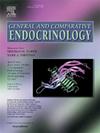Intelectin-1 promotes granulosa cells proliferation and modulates apoptosis via ERK1/2, AKT, and insulin receptor signaling pathways in Large White and Meishan pigs
IF 1.7
3区 医学
Q3 ENDOCRINOLOGY & METABOLISM
引用次数: 0
Abstract
Maintaining the proper balance between granulosa cells (Gc) proliferation and apoptosis is crucial for folliculogenesis and female fertility. Our previous study showed expression of omentin-1 (intelectin-1, ITLN1) in the porcine ovarian follicles; however, its impact on Gc functions remains unknown. Therefore, this study aimed to determine the in vitro effects of ITLN1 on Gc proliferation and apoptosis in Large White (LW) and Meishan (MS) pigs. These breeds were chosen due to their distinct reproductive characteristics: MS pigs are known for maintaining a higher number of follicles during the follicular phase and exhibiting greater estradiol synthesis compared to LW pigs. Porcine Gc were incubated with ITLN1 (10–100 ng/mL) for 24–72 h, and the viability/proliferation (alamarBlue/BrdU assays), cell cycle progression (flow cytometry) and the gene and protein expression of proliferation/apoptotic markers (PCNA, cyclins A1, B2, D1, E1, caspases-3, −9, BCL-2, BAX, FAS, FADD, XIAP) (real-time PCR, western blotting) were assessed. Next, the effect of ITLN1 on the phosphorylation of several kinases (AKT, AMPK, ERK1/2, STAT3, PKA) and the gene and protein expression of the insulin receptor (INSR) were studied (real-time PCR, western blotting). Then, using pharmacological inhibitors of ERK1/2 (PD98059, 5 μM), AKT (LY294002, 10 μM) and INSR (1 μM), treated alone or with ITLN1 (S961, 50 ng/mL), we analyzed its involvement in the effects of ITLN1 on Gc proliferation/apoptosis. We demonstrated that ITLN1 had a mitogenic effect on Gc by enhancing cell cycle progression and modulating the levels of PCNA, cyclins and apoptotic factors via ERK1/2, AKT, and INSR, suggesting that ITLN1 is a newly identified regulator in ovarian folliculogenesis, regardless of the fatness degree of pigs.

白细胞介素-1通过ERK1/2、AKT和胰岛素受体信号通路促进大白猪和梅山猪颗粒细胞增殖并调节细胞凋亡
维持颗粒细胞(Gc)增殖和凋亡之间的适当平衡对于卵泡发生和女性生育至关重要。我们之前的研究显示,omentin-1 (intellectual -1, ITLN1)在猪卵泡中表达;然而,它对Gc函数的影响仍然未知。因此,本研究旨在研究ITLN1对大白猪(LW)和梅山猪(MS) Gc增殖和凋亡的体外影响。选择这些品种是由于其独特的生殖特性:与LW猪相比,MS猪在卵泡期保持更多的卵泡,并表现出更多的雌二醇合成。将猪Gc与ITLN1 (10-100 ng/mL)孵育24-72 h,评估其活力/增殖(alamarBlue/BrdU测定)、细胞周期进展(流式细胞术)以及增殖/凋亡标志物(PCNA、cyclins A1、B2、D1、E1、caspase -3、−9、BCL-2、BAX、FAS、FADD、XIAP)的基因和蛋白表达(实时荧光定量PCR、western blotting)。接下来,研究ITLN1对AKT、AMPK、ERK1/2、STAT3、PKA等激酶磷酸化及胰岛素受体(INSR)基因和蛋白表达的影响(real-time PCR、western blotting)。然后,我们使用ERK1/2 (PD98059, 5 μM)、AKT (LY294002, 10 μM)和INSR (1 μM)的药理抑制剂,单独或联合ITLN1 (S961, 50 ng/mL),分析其参与ITLN1对Gc增殖/凋亡的影响。我们证明ITLN1通过促进细胞周期进程,通过ERK1/2、AKT和INSR调节PCNA、细胞周期蛋白和凋亡因子的水平,对Gc具有有丝分裂作用,这表明ITLN1是一种新发现的卵泡发生调节剂,与猪的肥胖程度无关。
本文章由计算机程序翻译,如有差异,请以英文原文为准。
求助全文
约1分钟内获得全文
求助全文
来源期刊

General and comparative endocrinology
医学-内分泌学与代谢
CiteScore
5.60
自引率
7.40%
发文量
120
审稿时长
2 months
期刊介绍:
General and Comparative Endocrinology publishes articles concerned with the many complexities of vertebrate and invertebrate endocrine systems at the sub-molecular, molecular, cellular and organismal levels of analysis.
 求助内容:
求助内容: 应助结果提醒方式:
应助结果提醒方式:


